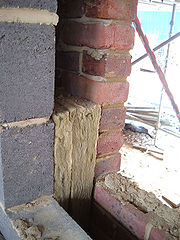
Cavity wall
Encyclopedia

Introduction
The masonryMasonry
Masonry is the building of structures from individual units laid in and bound together by mortar; the term masonry can also refer to the units themselves. The common materials of masonry construction are brick, stone, marble, granite, travertine, limestone; concrete block, glass block, stucco, and...
skins of a cavity wall can be brickwork
Brickwork
Brickwork is masonry produced by a bricklayer, using bricks and mortar to build up brick structures such as walls. Brickwork is also used to finish corners, door, and window openings, etc...
, blockwork or similar. Different masonry materials can be used on either side of the cavity. The cavity is initially empty but can be filled with insulation by various methods. Cavity walls are more time consuming –and therefore slightly more expensive– to build than walls with the two skins bonded together, but they provide better sound and heat insulation and most importantly resistance to rain penetration. For instance, in South Africa the building code requires cavity walls for residential buildings in coastal regions that have higher rainfall.
Insulation
An added benefit of cavity wall construction is that it provides the ability to more adequately insulate the building. A continuous layer of rigid insulation is easily fitted between the cavity and the inner skin of the wall. The insulation does not fill the cavity but rather slip in behind it. The cavity itself also helps in insulating the building by acting as a thermal breakThermal break
A thermal break or thermal barrier is an element of low thermal conductivity placed in an assembly to reduce or prevent the flow of thermal energy between conductive materials....
between the two skins of the wall.
With environmental conditions becoming more of an issue, people now take much more interest in reducing energy wastage and cavity wall insulation
Cavity wall insulation
Cavity wall insulation is used to reduce heat loss through a cavity wall by filling the air space with a porous material. This immobilises the air within the cavity , preventing convection, and can substantially reduce space heating costs.During construction of new buildings, cavities are often...
is a cost effective way to reduce the amount of heat (as much as 35%) lost from convection off walls. As well as being more environmentally friendly, it can reduce heating costs as more of the heat is used effectively and it is often used as a first step, due to its low payback time and smaller initial installation costs. As the demand for energy efficiency in buildings increases the issue of thermal bridging in cavity wall openings is becoming more prominent. Solutions to thermal bridging include cavity closers, an insulated frame seals the cavity at apertures for doors and windows.
Specification
A cavity wall is often flipped with a "half brick" thick outer skin and a dense concrete blockwork inner skin (100 mm). The "half brick" in bricklaying parlance actually refers to wall made with bricks laid end to end which just as a normal single-skinned brick wall would be — the "half" in reference to normal thickness which usually equates to "half the length" of the brick. For example, a brick might be 203 mm (8 in) long and 92 mm (3.6 in) wide which results in a single-skinned wall as thick as the brick is wide (92 mm in this example) and a double-skinnedDouble-skin facade
The Double Skin Façade is a system consisting of two skins placed in such a way that air flows in the intermediate cavity. The ventilation of the cavity can be natural, fan supported or mechanical...
(no cavity) wall as wide as the brick is long (203 mm). The single-skinned wall is therefore roughly half the thickness of the double-skinned wall, but only because most bricks are roughly twice as long as they are wide.
It is common for external brickwork to be exposed in order to create a visually appealing facade, and for the inner skin (often constructed of cheaper "plaster bricks" or cement blocks) to be plastered over, leaving no visible blockwork. Blockwork can also be used on both sides, and the external skin is either rendered or clad in another material.
The cavity may be partially or completely filled with thermal insulation from the damp-proof course upwards. The two leaves are connected by wall ties to spread lateral loads. Cavity sizes have to adhere to a certain minimum to prevent water penetration and typically are at least 50 mm to 100 mm. Sizes are increasing rapidly to accommodate super-insulating wall specifications, but the larger the cavity the more interior floor area is sacrificed.
The science of cavity insulation
The reason cavity insulation keeps heat in is that the polymer and air in the cavity are good insulators. This is because the distance between the particles in the air is greater than in a solid. Other benefits of cavity walls are their resistance to moisture from the outer side to the inner wall and the increase of sound proofing.History
The cavity wall method of construction was introduced into the United KingdomUnited Kingdom
The United Kingdom of Great Britain and Northern IrelandIn the United Kingdom and Dependencies, other languages have been officially recognised as legitimate autochthonous languages under the European Charter for Regional or Minority Languages...
during the 19th century and gained widespread use from the 1920s. In some early examples stones were used to tie the two leaves of the cavity wall together. Initially cavity widths were extremely narrow and were primarily implemented to prevent the passage of moisture into the interior of the building. The widespread introduction of insulation into the cavity began in the 1970s with it becoming compulsory in building regulations during the 1990s..

